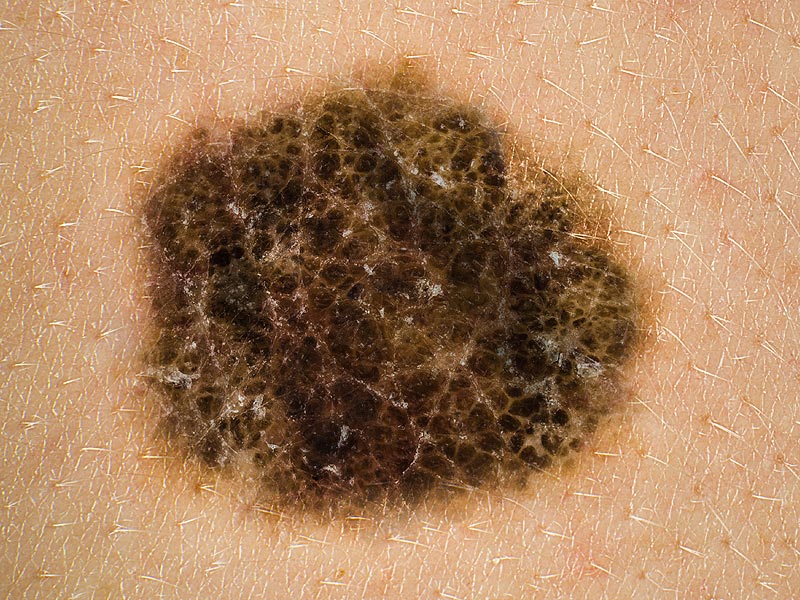Dr. Weeks’ Comment: Lympedema, the swelling of the armpit tissue after surgery, is a terrible consequence of the standard of care and now the science suggests it was not a good idea after all. Remember, the standard of care is not a static measure of competency. It is only sufficient until more science and better clinical results are demonstrated.
Full-Node Dissection Does Not Improve Survival in Melanoma
CHICAGO, IL ”” Complete lymph node dissection (CLND) in patients with melanoma with positive sentinel lymph node biopsy does not improve survival, according to the results of a new study.
“This is the first study that tested the typical recommendation of complete lymph node dissection in patients with positive sentinel nodes, and we cannot confirm this recommendation,” commented senior study author Claus Garbe, MD, a professor of dermatology at the University of Tübingen in Tübingen, Germany.
“And we expect that practice will change,” Dr Garbe said at a press briefing held here at the American Society of Clinical Oncology (ASCO) 2015 Annual Meeting.
Notably, only patients with micrometastases were included in this study. CLND will continue to be recommended for patients with larger, clinically detectable macrometastases, Dr Garbe noted.
At this time, CLND is considered the standard of care in patients with melanoma who are found to have sentinel node metastasis, and is recommended in National Comprehensive Cancer Network guidelines. But not all experts agree, citing mixed results about improved survival with the procedure and the risk for significant morbidities, such as lymphedema.
The results of this new randomized trial (n = 483) found no significant treatment-related difference in 5-year recurrence-free (P = .76), distant metastases-free (P = .76), and melanoma-specific (P = .86) survival between patients who underwent CLND and those who did not.
A total of 38 patients died of melanoma in the observation group compared with 36 who underwent CLND.
“We did not find any difference between the two study groups in terms of survival,” said Dr Garbe. “The distant metastases-free survival was nearly identical for both groups.”
At a median follow-up of 35 months, 14.6% of patients in the observation group developed lymph node regional metastases compared with 8.3% in the CLND group; the difference was not significant.
Only patients with micrometastases were included in this study, and CLND will continue to be recommended for those with larger, clinically detectable macrometastases, Dr Garbe noted.
Not Ready for Prime Time
It is still standard practice to suggest to patients with positive sentinel lymph nodes that they should undergo a second surgery, said ASCO expert Lynn Schuchter, MD, a melanoma specialist at the University of Pennsylvania in Philadelphia. But more and more, there have been questions about whether it is really necessary.
“I would say that this is a really important study, but it’s a relatively small study, and I don’t think we would make a complete change in our recommendations based on this data,” she said. “I think we will wait in making definitive changes in our management until we have results from a larger study.”
However, for patients who are concerned about lymphedema, this study does provide enough information to make them comfortable about a watch-and-wait approach, she added. Dr Garbe noted that lymphedema can occur in 20% of patients and can be long-term in about 5% to 10% of patients.
More Questions Need Answers
The new study prompts investigation of a number of patient management issues, said another expert.
“The majority of stage III melanoma patients present with a positive sentinel lymph node, which means their nodal disease was diagnosed at a microscopic level, rather than when a large lump had developed that the patient or their doctor could detect,” commented Vernon Sondak, MD, chair of the Cutaneous Oncology”Ž Department at Moffit Cancer Center, Tampa, Florida. He was approached by Medscape Medical News for independent comment.
“Because nodal disease is being diagnosed earlier, surgical treatment of the lymph node basin by completion lymph node dissection is able to be done earlier, when there are often fewer side effects of surgery than if it is done for larger sized nodal tumors,” he explained.
In contrast, if the nodal disease has been diagnosed early enough, then the melanoma may have only spread to the sentinel node, which has already been removed in the initial sentinel node biopsy procedure. “This means that completion lymph node dissection is likely unnecessary in a percentage of patients who are already cured by the biopsy,” he said.
“Finally, some patients will eventually die of distant metastatic tumors that have already been seeded before the completion lymph node dissection can take place, meaning that the more radical surgery could not impact their survival,” Dr Sondak continued.
“Unfortunately, we don’t know which patients are already cured by their sentinel node biopsy procedure, which ones are destined to die no matter what surgery is done, and which ones might be saved from recurring and dying ”” or at least from extra surgical side effects ”” by early use of lymph node dissection,” he said.”
“Randomized trials like this one and the much larger [MSLT-II] will help answer these important questions over the next few years,” he added.
This study was funded by German Cancer Aid. Several of the authors report relationships with industry, as noted in the abstract.
American Society of Clinical Oncology (ASCO) 2015 Annual Meeting: Abstract LBA 9002. Presented May 30, 2015.


